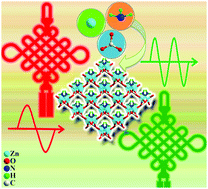Zn(NH3)CO3: a “three-in-one” UV nonlinear optical crystal built by a polar molecule bonding strategy†
Abstract
Noncentrosymmetric (NCS) crystals are of great interest because of their functions, such as nonlinear optical (NLO) properties, but their syntheses are still difficult. Remarkably, polar inorganic molecules often have a “Midas touch” in the process of the crystallization of NCS structures. Zn(NH3)CO3 has a “three-in-one” NLO-active motif which includes a polar NH3 molecule, polar displaced Zn2+, and π-conjugated CO32− ions. Zn(NH3)CO3 shows a second harmonic generation (SHG) response of 1.5× KH2PO4, a short UV cut-off edge of 204 nm, suitable birefringence (0.087 at 546 nm), a short SHG phase-matching wavelength (shortest λPM = 217 nm), a high laser damage threshold (LDT) (126.3 MW cm−2), and good stability. Meanwhile, Zn(NH3)CO3 with a structure like a Chinese knot has excellent crystal growth that makes it easy to obtain centimeter sized blocky crystals. For the first time, ZnO3(NH3) is used as a new NLO-active motif to explore the formation of NCS zinc carbonate. This research sheds new light on polar molecule bonding strategies to build desired NCS structures, and it reveals for the first time ammine complexes for use as new UV NLO crystals with a bright future.

- This article is part of the themed collection: Journal of Materials Chemistry C HOT Papers


 Please wait while we load your content...
Please wait while we load your content...